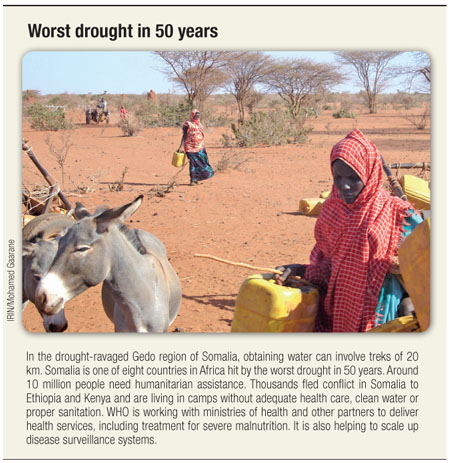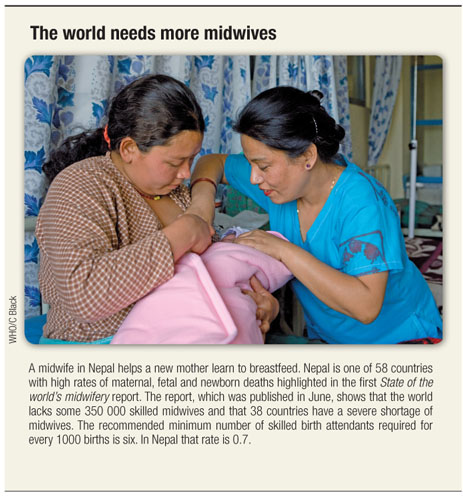NEWS
Public health round-up

Promising progress
The world is on track to reduce poverty to less than 15% of the population by 2015 well below the 23% target, according to the Millennium Development Goals report 2011. Launched on 7 July by United Nations Secretary-General Ban Ki-Moon, the report found that significant progress has been made in reducing poverty in other areas such as child mortality, illiteracy and some infectious diseases countries are lagging. www.un.org/millenniumgoals
Adolescents at risk
Every day, around 2500 young people become infected with HIV. For the first time a United Nations publication, Opportunity in crisis: preventing HIV from early adolescence to young adulthood, presents global data on adolescents and HIV. The report reveals stark gender inequalities, particularly in sub-Saharan Africa where 72% of young people (aged 1524) living with HIV are women. Young women and girls face a disproportionately high risk of infection due to biological vulnerability, social inequality and exclusion. http://www.who.int/hiv/pub/opportunity_in_crisis
Affordable HIV drugs
Poor countries often wait years before they can afford new medicines for HIV. This is set to change. The Medicines Patent Pool, developed by global health initiative UNITAID, announced on 12 July an agreement with Gilead Sciences, its first to date with a pharmaceutical company. The Pool seeks to stimulate innovation and improve access to HIV medicines through the negotiation of voluntary licences on medicine patents. The aim is to enable generic production and development of new formulations including for children. "I welcome this first important step by Gilead and urge other pharmaceutical companies to place their intellectual property at the service of global public health," said Philippe Douste-Blazy, chair of the UNITAID Executive Board.
Safe water
Every year an estimated two million people die from waterborne diseases and many more suffer illness from drinking unsafe or contaminated water. On 4 July, during International Water Week in Singapore, WHO released new Guidelines for drinking-water quality, calling on governments to adopt a primary prevention approach in their water safety management. The new guidelines recommend that water suppliers systematically assess the risk of contaminants entering the water supply, and that they take action based on their findings and document the process. "If we look at the most recent waterborne disease outbreaks, both in developing and developed countries, it is clear that most of these could have been prevented through the proactive implementation of water-safety plans," said Robert Bos, coordinator for Water, Sanitation, Hygiene and Health at WHO. http://www.who.int/water_sanitation_health/publications/2011/dwq_guidelines
Stigma stands in the way
WHO has launched the first public health guidelines on HIV services for men who have sex with men and transgender people. Men who have sex with men are nearly 20 times more likely to be HIV positive than the general population. But often they are reluctant to approach HIV prevention and treatment services due to the stigma and discrimination they face and, in some countries, because same-sex relationships are illegal. The guidelines suggest practical ways to improve access to such services. http://www.who.int/hiv/pub/guidelines/msm_guidelines2011
Research scan
Screening for syphilis
More than 50% of newborn deaths and stillbirths related to syphilis could be prevented with low-cost screening and treatment during pregnancy, according to research published in The Lancet Infectious Diseases. Around 2.1 million pregnant women are estimated to have active syphilis. Without screening and treatment, 69% of these women will have an adverse outcome of pregnancy. Nearly 500 000 babies die of congenital syphilis every year in sub-Saharan Africa alone. http://www.thelancet.com/journals/laninf/article/PIIS1473-3099(11)70104-9/abstract
Does cutting salt help?
Reducing salt intake is commonly recommended to reduce the risk of cardiovascular disease, such as stroke and heart attacks. But a new study has found that there is no clear evidence to support this. A Cochrane review published in July in the American Journal of Hypertension analysed seven randomized controlled trials covering more than 6500 participants. Although cutting down on salt reduced blood pressure after six months, the study did not find enough evidence to show that sodium intake affected the participants' cardiovascular disease and deaths. It concluded that more research is needed on the effects of reducing salt intake, including "hidden salt" in processed foods. http://onlinelibrary.wiley.com/o/cochrane/clsysrev/articles/CD009217/frame.html

Cooking ups blood pressure
An estimated two billion people in the world cook with a biomass fuel, such as wood, exposing themselves to high doses of pollution. A study published last month in Environmental Health Perspectives has linked indoor air pollution with increased blood pressure among women aged 5059. The study of 280 women in a remote part of China found that a reduction in this kind of pollution was linked to a drop in systolic blood pressure. "We have known for years that unvented cooking indoors causes respiratory damage, but now that we have documented cardiovascular effects as well, the rationale for cleaner stoves and better fuels becomes that much stronger," said co-author Jonathan Patz from the Nelson Institute for Environmental Studies, United States of America. http://ehp03.niehs.nih.gov/article/fetchArticle.action?articleURI=info%3Adoi%2F10.1289%2Fehp.1003371
The cost of cancer
If Canada's average smoking rates were cut by half, i.e. to 11% of the population within five years, there would be 36 000 fewer cases of lung cancer by 2030, which could save about US$ 670 million in treatment costs alone. New cancer projection technology was launched last month in Amsterdam at the 14th World Conference on Lung Cancer. The tool, developed for the Canadian Partnership Against Cancer, uses demographic data to project cancer occurrences and explore the impact of smoking cessation and screening programmes on treatment costs, life-years gained and tax revenue. 
Looking ahead
17 August: World Breastfeeding Week http://worldbreastfeedingweek.org
9 August: International Day of the World's Indigenous People http://www.un.org/en/events/indigenousday
19 August: World Humanitarian Day http://ochaonline.un.org/whd
10 September: World Suicide Prevention Day http://www.iasp.info/wspd
1923 September: United Nations Summit on Chronic Diseases (High-level meeting of the United Nations General Assembly on the Prevention and Control of Noncommunicable Diseases) http://www.who.int/nmh/events/2011/ncd_summit
21 September: International Day of Peace http://www.internationaldayofpeace.org
24 September: World Heart Day http://www.world-heart-federation.org
1 October: International Day of Older Persons http://www.un.org/en/events/olderpersonsday
4 October: World Habitat Day http://www.unhabitat.org/categories.asp?catid=669
10 October: World Mental Health Day http://www.wfmh.org/00WorldMentalHealthDay.htm
14 October: World Sight Day http://www.vision2020.org
15 October: Global Handwashing Day http://www.globalhandwashingday.org
16 October: World Food Day http://www.fao.org/getinvolved/worldfoodday
17 October: International Day for the Eradication of Poverty http://www.oct17.org/en
20 October: World Statistics Day http://unstats.un.org/unsd/wsd
1921 October: World Conference on Social Determinants of Health. Rio de Janeiro, Brazil.
